PDF Attached
Lower
trade in soybeans and corn on improving South American weather and widespread market selling. Chicago and KC wheat ended higher in part to short covering. Look for positioning ahead of the USDA reports due out on Wednesday.

Weather

WEATHER
EVENTS AND FEATURES TO WATCH
- Argentina
was dry Friday through Sunday afternoon and temperatures were slightly warmer than usual - Highest
temperatures were in the upper 80s and lower 90s in the south and in the 90s to 106 in the north…..Sunday was hottest - Argentina
will be progressively heating up through Saturday with very little rainfall
- Highest
temperatures in the middle 90s to 113 degrees are expected with a few hotter readings late this week - Argentina
will experience some showers late Saturday into next Sunday and they will increase through mid-week next week - Rainfall
will be great enough to reduce temperatures back to a more seasonably warm range - Rain
amounts will vary from 0.50 to 1.50 inches with a few totals of 2.00 to 4.00 inches - Greatest
rainfall in the north - Some
weak ridge building will occur during mid- to late week next week in the north forcing rainfall to southern parts of the nation late in the week and during the following weekend - Rainfall
in the south will vary from 0.30 to 1.00 inch with a few 1.00 to 2.00-inch amounts
- Showers
and thunderstorms will shift northward in the second weekend of the two-week outlook with seasonable temperatures returning - Argentina’s
bottom line is quite stressful for crops and livestock this week through Saturday due to hot temperatures, no rain and no soil moisture with deteriorating grazing and crop conditions. Some relief is expected next week and into the following weekend due to
periodic showers and thunderstorms and less oppressive heat. Follow up rain will be very important. Some of the early planted corn and sunseed have already lost yield potential and there is some concern that recently planted crops may have withered and died
or about to do the same. Crops from southeastern San Luis and southern Cordoba through northeastern La Pampa to central Buenos Aires have suffered the least damage, but are being stressed more significantly this week making next week’s rainfall extremely important.
- Brazil
rainfall during the weekend continued frequent and significant from eastern Mato Grosso and Tocantins to Minas Gerais and parts of western Bahia, including portions of Goias
- Rainfall
varied from 1.25 to more than 4.00 inches - A
few locations in east-central Minas Gerais received 4.00 to 6.22 inches of rain resulting in some flooding - Rain
also fell in southern and central Mato Grosso do Sul, western Parana and portions of southern Paraguay with amounts of 0.30 to 1.50 inches and local totals to 2.28 inches
- Temperatures
were cooler than usual in the heavier rainfall areas and near normal in most other areas - Brazil
rainfall will be decreasing this week and limited, although not absent, this weekend and next week - Rainfall
for the week will vary from nothing in parts of Rio Grande do Sul, western Santa Catarina and Paraguay to between 2.00 and 5.00 inches from northeastern Sao Paulo and southern Minas Gerais into eastern Mato Grosso and parts of Tocantins - The
first half of this week will be wettest - Rainfall
in Parana and Mato Grosso do Sul will vary from 0.30 to 1.50 inches - Eastern
Bahia and parts of northern Espirito Santo will also experience less than 1.00 inch of moisture - Temperatures
will continue near to below normal early this week and more seasonable late this week and in the weekend - Brazil
weather will include more sporadic rainfall during the weekend and next week, but daily showers and thunderstorms will impact 30-50% of the nation each day - Rainfall
will vary from 0.20 to 0.75 inch with a few amounts to 1.50 inches each day - Temperatures
will gradually become near to slightly warmer than usual as the precipitation becomes lighter and more sporadic
- Brazil’s
bottom line is one of improvement for the nation’s crops, but especially those that have been too wet recently. Less frequent and less significant rain in early maturing corn and soybean production areas will be ideal in promoting better drying conditions
late this week into next week. Harvest progress is expected to become more aggressive during this period of time which should lead to some aggressive Safrinha crop planting as well. Recent rain in the interior south has brought on improved crop development
conditions after being too dry early this growing season. Rio Grande do Sul is the only exception where the state is expected to experience a steadily decreasing soil moisture profile and rising crop stress. The same is true for Paraguay. Rio Grande do Sul
may get some rain and a break from drying in the middle to latter part of next week.
- New
South Wales, Australia will receive periodic showers and thunderstorms this week supporting cotton, sorghum and other summer crops - Rainfall
of 0.25 to 1.00 and a few 1.00 to 3.00-inch amounts are expected - Queensland,
Australia is unlikely to get much “meaningful” moisture this week, although a few showers will evolve - Greater
rain is needed for dryland production areas - Queensland
may continue to experience erratic rainfall as will New South Wales during the weekend and next week - Eastern
Australia could experience a boost in precipitation during the latter part of next week and if that evolves it would be a boon to the nation’s unirrigated summer crops and would bolster soil moisture and water supply for future irrigation - Australia
temperatures will be warmer than usual in western Queensland, western New South Wales and neighboring areas where rainfall may not be as great as needed to protect livestock grazing areas from further deterioration. - Rain
is needed on these areas - Australia’s
bottom line is one of needed rain in Queensland’s unirrigated grain, oilseed and cotton areas as well as all of eastern Australia’s livestock country, but especially in the west. No serious changes to dryness in western parts of Queensland or New South Wales
during the next ten days. - South
Africa rainfall was erratic during the weekend as it will be through the next two weeks, but all areas will be impacted at one time or another and sufficient rain will occur to support crop needs - Yield
potentials remain high and “some” of the worry over wet weather diseases has been reduced with less rainfall recently - India
rainfall was widespread during the weekend from northern Madhya Pradesh through Rajasthan and northern and central Uttar Pradesh to northern Pakistan and northern Uttarakhand - Some
rainfall varied from 1.00 to 3.00 inches from Haryana and northwestern Uttar Pradesh to Jammu and Kashmir and far northern Pakistan - Rainfall
in northern India and Pakistan since January 1 has been widespread and significant enough to help improve production potentials for 2022 - Follow
up rain will be needed in February while crops are reproducing and beginning to fill, but the crop is poised to perform very well - India
weather this week will support more rain in east-central and southeastern parts of the nation expanding the area benefiting from significant moisture - The
precipitation will be greatest from southeastern Madhya Pradesh through Chhattisgarh into Odisha and northeastern Andhra Pradesh where rainfall will range from 0.75 inch to 2.00 inches with local totals over 3.00 inches
- Net
drying is expected elsewhere, but especially in the western half of the nation - U.S.
weekend weather included widespread precipitation from the western and northern Delta through the lower eastern Midwest - Moisture
totals varied from 0.50 to over 2.00 inches with the northern Delta to Kentucky wettest
- Flooding
continues in areas from northeastern Arkansas into southwestern Indiana and portions of Kentucky and these areas and many in neighboring parts of the Tennessee River Basin and the middle Ohio River Basin need to dry down - Rain
and mountain snow fell in the Pacific Northwest, but the central valleys of Washington, Oregon and Idaho failed to receive much moisture - Dry
weather occurred in most other areas - Temperatures
were quite cold early in the weekend with low temperatures in the single digits and teens across the lower Midwest and central Plains while in the negative teens and negative single digits in the northern Plains and upper Midwest - Warming
did occur in the second half of the weekend - Canada’s
Prairies turned a little warmer during the weekend with additional snow falling in many areas - Canada’s
southwestern Prairies are still drier than usual with moisture totals less than 0.25 inch over the next two weeks
- Snow
cover is still limited in east-central and southern Alberta and central, west-central and southwestern parts of Canada’s Prairies - This
is the most seriously drought stricken part of the Prairies and not much relief is likely prior to spring - Europe
weather during the weekend was wettest in France and a part of the United Kingdom and western Germany while scattered showers of light intensity occurred in southeastern parts of the continent - Rainfall
ranged from 1.00 to 2.25 inches in southwestern France while varying up to 0.80 inch elsewhere in France - Precipitation
in the forms of rain and snow fell in Germany, the U.K. and from the Italian Peninsula through the Balkan Countries to Ukraine and southern Belarus where moisture totals varied up to 0.60 inch - Most
other areas were dry biased - Temperatures
were mild to cool, but non-threatening to dormant winter crops - Europe
precipitation during the next two weeks will be restricted especially in the western half to two-thirds of the continent
- Spain
is the only nation that would benefit greatly from more significant precipitation, but little to none is expected for a while - Soil
moisture is expected to be favorable across the continent during the next two weeks, despite limited precipitation - There
will be no threatening cold weather - Western
Russia, Belarus, Ukraine and Baltic States will get light and sporadic precipitation during the coming week with a boost in snow and a little rain next week - There
will be no threatening cold temperatures, but cooling is expected next week and the snow will be sufficient protection for the coldest areas to protect wheat - North
Africa precipitation was limited to Tunisia and northeastern Algeria during the weekend - Rainfall
was heavy near the northeastern Algeria and northwestern Tunisia border where 1.00 to 4.50 inches resulted - Lighter
rain surrounded this region with amounts to 0.60 inch - Most
other areas in North Africa were dry and will continue dry during much of the next ten days - Southwestern
Morocco continues to be in a notable multi-year drought while dryness is also a concern in northwestern Algeria - Crops
elsewhere are doing relatively well - China’s
weather will continue mostly uneventful for a while, although periods of rain and a little snow will impact the Yangtze River Basin and areas southward during the next couple of weeks.
- The
moisture will preserve the integrity of the 2022 rapeseed and southern wheat crops - Snow
will fall periodically in the far northeast while the Yellow River Basin and southern coastal provinces receive little to no precipitation - The
southern coastal provinces will eventually become too dry and this may lead to some concern about early rice planting in March, but there is plenty of time for change - Temperatures
will be near to slightly warmer than usual - Southeast
Asia oil palm, citrus, sugarcane, coffee, cocoa, rice and other crop areas of Indonesia, Malaysia and Philippines will receive frequent bouts of rain over the next two weeks - Some
heavy rain is possible, but no serious widespread flood problem is expected - Local
flooding will be possible, though - Mainland
areas of Southeast Asia will be mostly dry during the next ten days except Vietnam coastal areas where some moderate rain will be possible late this week and into the weekend - Northernmost
Laos and northern Vietnam coffee, rice and other crop areas will get some rain late this week and especially Saturday through Monday, Jan. 17. - West-central
Africa precipitation will be limited to coastal areas and temperatures will be a little warmer than usual - East-central
Africa will be erratic, but it is expected daily through the next ten days supporting coffee, cocoa, rice sugarcane and other crops - Middle
East precipitation is increasing with improved soil moisture likely over the next ten days - Some
beneficial moisture has already occurred in Pakistan, Afghanistan, Iraq and Iran - Winter
crops will benefit from whatever rain falls, but it is not expected to be evenly distributed for a while - Mexico
weather will trend wetter along the east coast for a little while this week
- Most
other areas will be dry for the next ten days - Rain
was removed from the forecast in northern Mexico overnight - Central
America precipitation will be greatest along the Caribbean Coast , but including a fair amount of Panama and Costa Rica during the next ten days - A
few showers will occur in Guatemala periodically as well, although rainfall will be light - Western
Colombia and western Venezuela precipitation is expected to occur periodically in coffee, corn, rice and sugarcane production areas during the next ten days, but no excessive rain is expected - Interior
Colombia and many areas in Venezuela have received less than usual precipitation in the past 30 days, but the greatest dryness may be outside of key crop areas - Today’s
Southern Oscillation Index was +7.04 and it was expected to continue falling for a while this week. The index peaked at +13.07 December 31.
New
Zealand rainfall is expected to continue getting less than usual precipitation this week with temperatures near to above normal.
Source:
World Weather, inc.
Monday,
Jan. 10:
- USDA
export inspections – corn, soybeans, wheat, 11am - Malaysian
Palm Oil Board’s data for December output, exports and stockpiles - Malaysia’s
Jan. 1-10 palm oil exports - Ivory
Coast cocoa arrivals - HOLIDAY:
Japan
Tuesday,
Jan. 11:
- EU
weekly grain, oilseed import and export data - Brazil’s
Conab releases data on area, yield and output of corn and soybeans
Wednesday,
Jan. 12:
- China
farm ministry’s CASDE outlook report - USDA’s
monthly World Agricultural Supply and Demand Estimates (WASDE) report, noon - USDA’s
NASS 2021 summary of crop acreages and yields, noon - USDA’s
quarterly stockpiles data for commodities, including wheat, barley, corn, soybeans and sorghum, noon - EIA
weekly U.S. ethanol inventories, production - USDA’s
Farm Service Agency issues 2021 crop size data gathered from producers, 1pm - New
Zealand Commodity Price
Thursday,
Jan. 13:
- USDA
weekly net-export sales for corn, soybeans, wheat, cotton, pork and beef, 8:30am - Suedzucker
quarterly earnings - Agrana
nine- month earnings - International
Grains Council monthly report - Port
of Rouen data on French grain exports
Friday,
Jan. 14:
- China’s
December trade data - ICE
Futures Europe weekly commitments of traders report, ~1:30pm - CFTC
commitments of traders weekly report on positions for various U.S. futures and options, 3:30pm
Source:
Bloomberg and FI

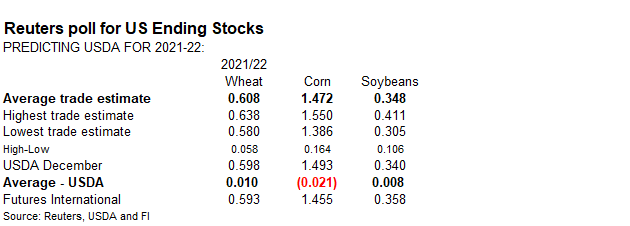


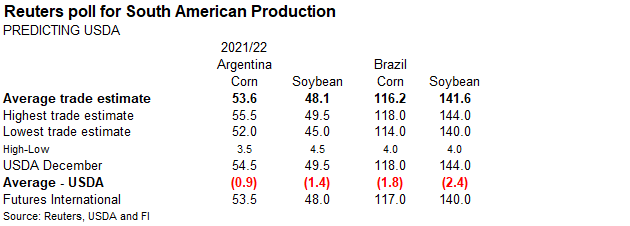

Bloomberg
trade estimates for the January USDA crop/stocks reports.





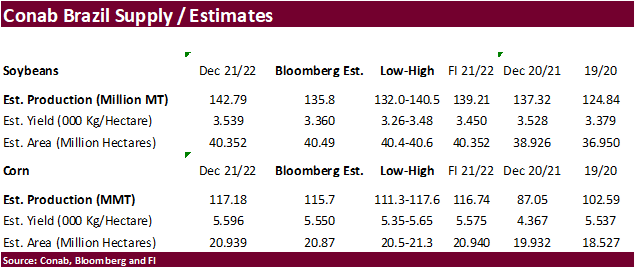
USDA
inspections versus Reuters trade range
Wheat
233,159 versus 175000-400000 range
Corn
1,022,677 versus 600000-1250000 range
Soybeans
905,149 versus 950000-1500000 range

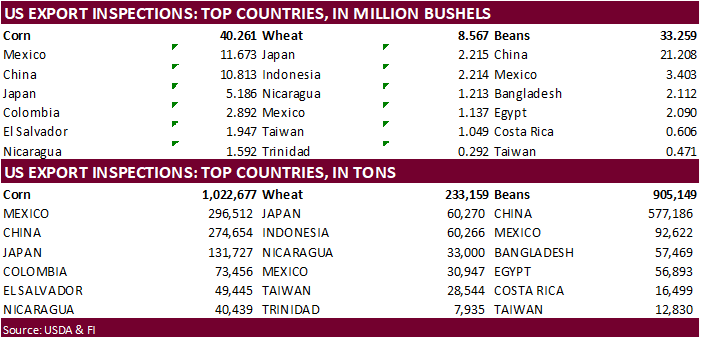
GRAINS
INSPECTED AND/OR WEIGHED FOR EXPORT
REPORTED IN WEEK ENDING JAN 06, 2022
— METRIC TONS —
————————————————————————–
CURRENT PREVIOUS
———–
WEEK ENDING ———- MARKET YEAR MARKET YEAR
GRAIN 01/06/2022 12/30/2021 01/07/2021 TO DATE TO DATE
BARLEY
0 0 0 10,010 20,944
CORN
1,022,677 759,563 1,345,367 14,084,268 16,564,135
FLAXSEED
0 0 0 224 461
MIXED
0 0 0 0 0
OATS
0 0 0 300 2,593
RYE
0 0 0 0 0
SORGHUM
201,482 1,951 133,461 1,930,821 2,481,721
SOYBEANS
905,149 1,614,158 1,909,217 31,646,567 41,129,711
SUNFLOWER
0 0 0 432 0
WHEAT
233,159 230,361 281,356 12,431,651 15,296,793
Total
2,362,467 2,606,033 3,669,401 60,104,273 75,496,358
————————————————————————–
CROP
MARKETING YEARS BEGIN JUNE 1 FOR WHEAT, RYE, OATS, BARLEY AND
FLAXSEED;
SEPTEMBER 1 FOR CORN, SORGHUM, SOYBEANS AND SUNFLOWER SEEDS.
INCLUDES
WATERWAY SHIPMENTS TO CANADA.
Soybean
and Corn Advisory
2021/22
Brazil Soybean Estimate Lowered 3.0 mt to 135.0 Million
2021/22
Argentina Soybean Estimate Lowered 2.0 mt to 43.0 Million
2021/22
Paraguay Soybean Estimate Unchanged, Could Move Lower
2021/22
Brazil Corn Estimate Lowered 1.0 mt to 112.0 Million
2021/22
Argentina Corn Estimate Lowered 1.0 mt to 51.0 Million
Macros
76
Counterparties Take $1.560 Tln At Fed Reverse Repo Op. (prev $1.530 Tln, 75 Bids)
US
Wholesale Inventories (M/M) Nov F: 1.4% (est 1.2%; prev 1.2%)
US
Wholesale Trade Sales (M/M) Nov: 1.3% (prev R 2.5%) ***
New
Covid variant called ‘Deltacron’ detected in Cyprus; 25 cases so far
·
CBOT corn traded and ended lower from weakness in soybeans but a reversal in wheat limited losses. Improving South American weather was the driver to the downside, with bear spreading a feature. Rain will develop across southern
Brazil and Argentina later this week into next week. Over the weekend it was hot and dry.
·
WTI crude oil and equities were lower by the time CBOT ags closed but some stocks minimized losses by the end of the day.
·
Funds sold an estimated net 11,000 corn contracts.
·
USDA US corn export inspections as of January 06, 2022 were 1,022,677 tons, within a range of trade expectations, above 759,563 tons previous week and compares to 1,345,367 tons year ago. Major countries included Mexico for 296,512
tons, China for 274,654 tons, and Japan for 131,727 tons.
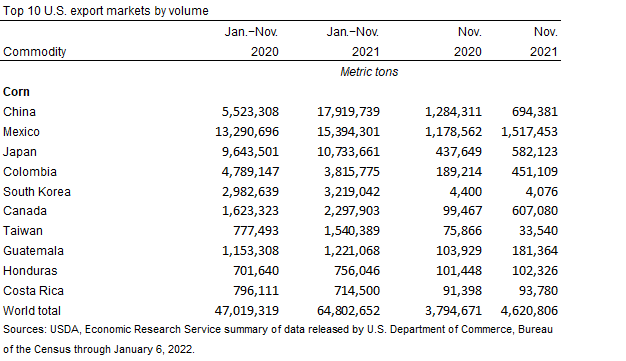
Export
developments.
·
The Korea Feed Association (KFA) bought around 130,000 tons of optional origin corn in two consignments each of about 65,000 tons, both at an estimated $334.17 a ton c&f. The first consignment was sought for arrival around March
30 and second consignment was sought for arrival around April 20.
·
Under the 24-hur announcement system, private exporters sold 132,000 tons of corn to Mexico, 77,000 for the current crop year and 55,000 tons new-crop.

Solar
power will account for nearly half of new U.S. electric generating capacity in 2022
https://www.eia.gov/todayinenergy/detail.php?id=50818&src=email
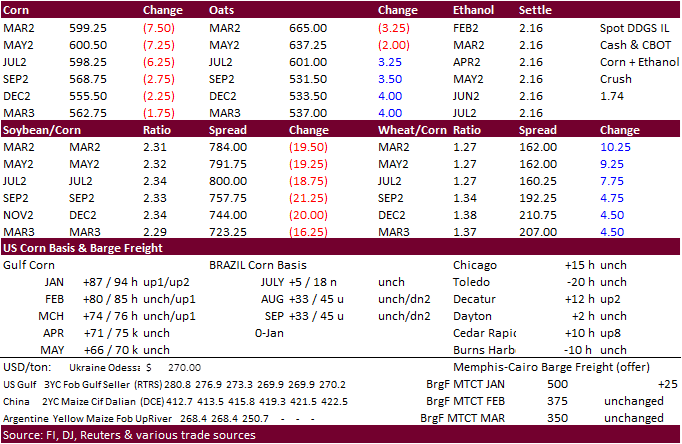
Updated
1/10/22
March
corn is seen in a $5.70 to $6.20 range (up 10 cents, unchanged back end)
·
CBOT soybeans ended lower on improving South American weather, poor USDA export inspections, and technical selling. Note March soybeans rallied and closed above $14/bu on Friday. March settled $13.8475, down 25.50 cents. USD was
23 points higher mid-afternoon. Funds are still holding a large net long position and long liquidation may continue on Tuesday as traders position ahead of the USDA reports due out Wednesday.
·
Funds sold an estimated net 14,000 soybeans, 5,000 soybean meal and 4,000 soybean oil.
·
Soybean oil traded two-sided in part to bullish Malaysian palm oil stocks data but was lower for the majority of the day session on weakness in WTI crude oil and lower soybeans. Soybean meal struggled to trade higher but ended
the day sharply lower. US soybean meal basis increased $5/short ton to 45 over the March for Claypool, IN and rose $5/short ton to 10 under for Mankato, MN.
·
USDA US soybean export inspections as of January 06, 2022 were 905,149 tons, below a range of trade expectations, below 1,614,158 tons previous week and compares to 1,909,217 tons year ago. Major countries included China for 577,186
tons, Mexico for 92,622 tons, and Bangladesh for 57,469 tons.
·
Brazil started harvesting in Parana and Mato Grosso. Yields in Parana are coming in at very low levels.
·
Russia’s export duty on sunflower oil exports from February 1 will be $251.4 per ton, compared to $280.8 per ton in January 2022. The duty was calculated on the basis of the indicative price of $1,359.2 per ton.
·
Heavy rains and thunderstorms fell today over parts of Indonesia’s Sumatra and Kalimantan.
·
Cargo surveyor AmSpec reported Malaysian Jan 1-10 palm exports at 318,928 million tons, 41.4% below the same period a month ago of 544,059. Cargo surveyor ITS reported Malaysian palm exports at 334,750 tons, 41.5 percent below
572,689 tons from the same period a month ago.

·
Malaysian palm futures traded higher by 36 ringgit to 5,029. Overnight the contract hit an absolute record high of 5,123.
August
– November Canadian canola oil production
is running 14 percent below the same period year earlier.

Source:
TNS, StatsCan, and FI
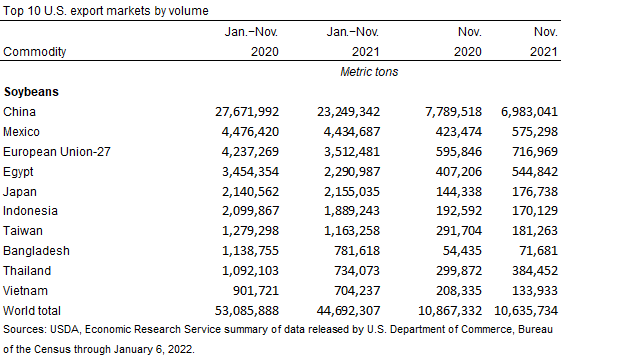
Export
Developments
·
The USDA bought 12,000 tons of bulk crude degummed soybean oil for export, under the Food for Progress export program, to the Dominican Republic. Price paid was reported at $1,388 per ton, with delivery Feb 5-15. (TNS)
·
The USDA seeks 7,540 tons of vegetable oil in 4 liter cans for Feb 16-Mar 15 shipment on January 19.
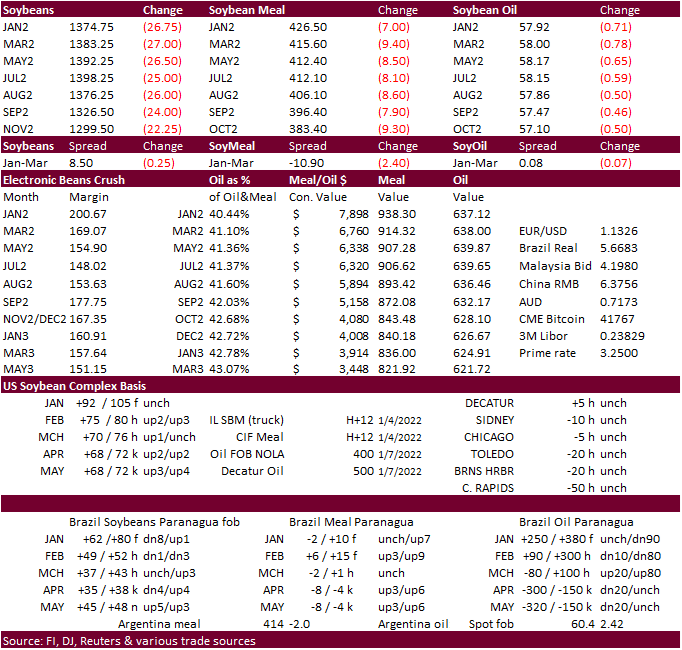
Updated
1/10/22
Soybeans
– March $13.00-$14.25
Soybean
meal – March $370-$435
Soybean
oil – March 54.50-61.00
(up 150, unchanged back end)
·
Unlike soybean and corn, funds are net short Chicago wheat and today we saw short covering in Chicago that spilled over into KC type wheat. KC was also supported on weather forecasts calling for dry conditions across the central
and southern Great Plains. MN wheat finished lower on advancing Australian harvesting progress and little issues with the US upper Great Plains and Canadian weather forecasts. Positioning ahead of the USDA reports due out on Wednesday may keep wheat in a two-sided
range over the next day.
·
Funds bought an estimated net 2,000 SRW wheat contracts.
·
USDA US all-wheat export inspections as of January 06, 2022 were 233,159 tons, within a range of trade expectations, above 230,361 tons previous week and compares to 281,356 tons year ago. Major countries included Japan for 60,270
tons, Indonesia for 60,266 tons, and Nicaragua for 33,000 tons.
·
EU wheat basis the March position was 0.75 higher at 275.50 euros a ton.
·
Euronext will launch durum wheat futures on Tuesday.
·
Ukraine exported 33.5 million tons of grain so far in the 2021-22 July-June season, up 23.2% from the same stage a season earlier. That included 16.1 million tons of wheat, 5.3 million tons of barley and 11.8 million tons of corn.
Ukraine took in a record 84 million tons of grain in clean weight in 2021, up from 65 million tons in 2020.
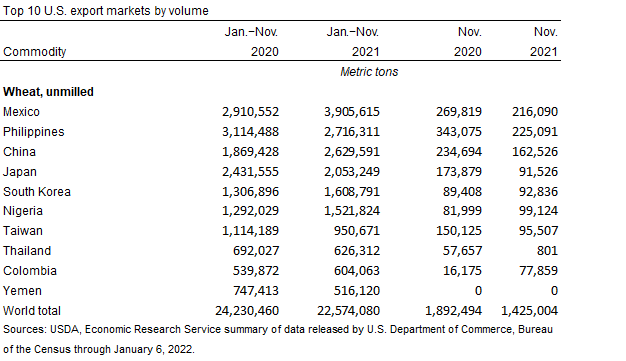
·
China sold 100% or 506,568 tons of 2014-2020 crop-year wheat on January 5, to local millers at an average price of 2,707 yuan ($424.73) per ton. China sold 891,938 tons of wheat at an auction from state reserves in October.
·
China plans to sell 500,000 tons of wheat from state reserves on January 12 to flour millers.
·
Jordan seeks 120,000 tons of wheat on January 18. Possible shipment combinations are in 2022 between July 1-15, July 16-31, Aug. 1-15 and Aug. 16-31.
Rice/Other
·
(Bloomberg) — U.S. 2021-22 cotton ending stocks seen as 3.46m bales, slightly above USDA’s previous est., according to the avg in a Bloomberg survey of seven analysts. Estimates range from 3.0m to 3.85m bales. Global ending
stocks seen 125,000 bales lower at 85.61m bales.
·
Bangladesh seeks 50,000 tons of rice on January 16.
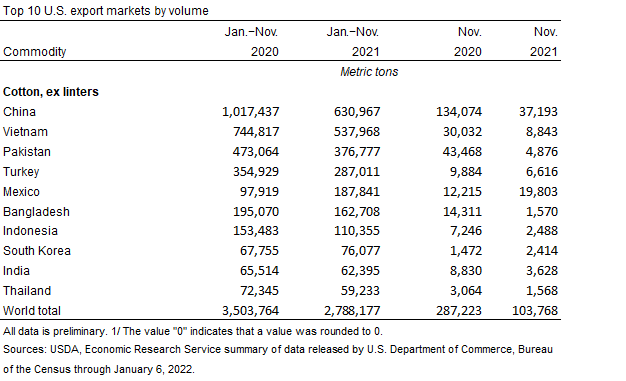
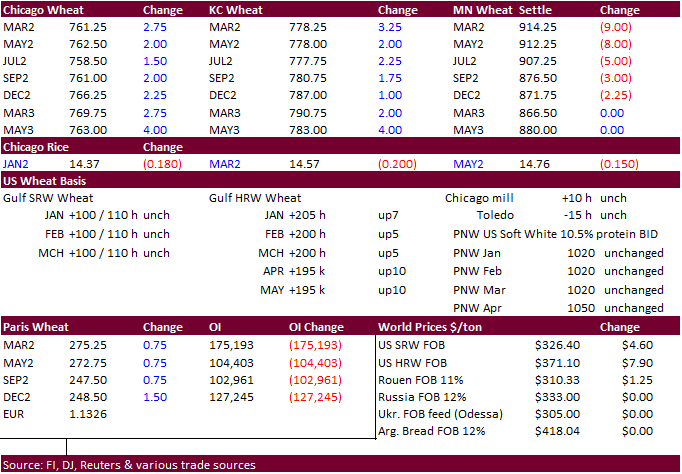
Updated
1/10/22
Chicago
March $7.20 to $8.40 range (down 20, down 20)
KC
March $7.55 to $8.75 range (unchanged, down 25)
MN
March $8.75‐$10.00
Terry Reilly
Senior Commodity Analyst – Grain and Oilseeds
Futures International
One Lincoln Center
18 W 140 Butterfield Rd.
Oakbrook Terrace, Il. 60181
W: 312.604.1366
ICE IM:
treilly1
Skype: fi.treilly

Trading of futures, options, swaps and other derivatives is risky and is not suitable for all persons. All of these investment products are leveraged, and you can lose more than your initial deposit. Each investment product is offered
only to and from jurisdictions where solicitation and sale are lawful, and in accordance with applicable laws and regulations in such jurisdiction. The information provided here should not be relied upon as a substitute for independent research before making
your investment decisions. Futures International, LLC is merely providing this information for your general information and the information does not take into account any particular individual’s investment objectives, financial situation, or needs. All investors
should obtain advice based on their unique situation before making any investment decision. The contents of this communication and any attachments are for informational purposes only and under no circumstances should they be construed as an offer to buy or
sell, or a solicitation to buy or sell any future, option, swap or other derivative. The sources for the information and any opinions in this communication are believed to be reliable, but Futures International, LLC does not warrant or guarantee the accuracy
of such information or opinions. Futures International, LLC and its principals and employees may take positions different from any positions described in this communication. Past results are not necessarily indicative of future results.
